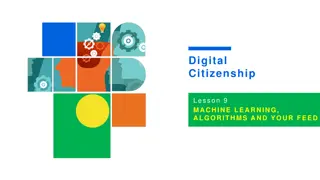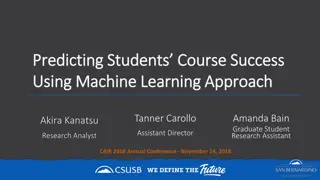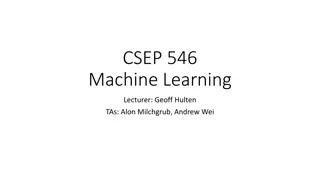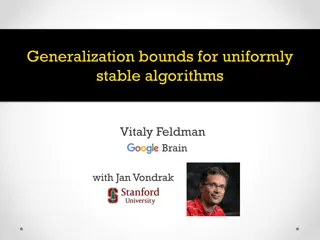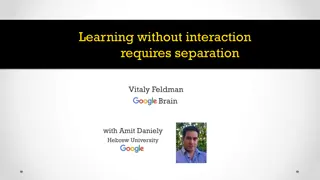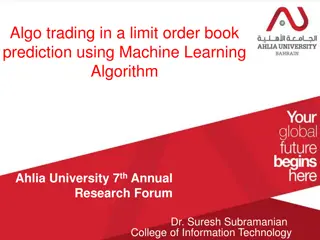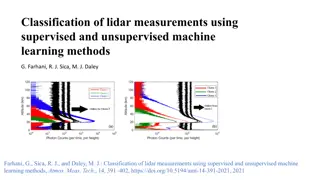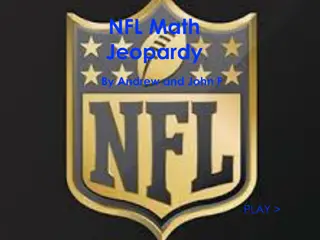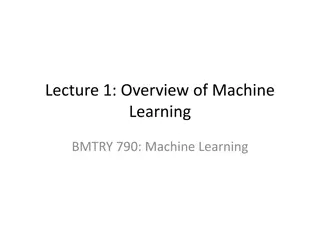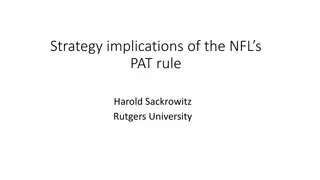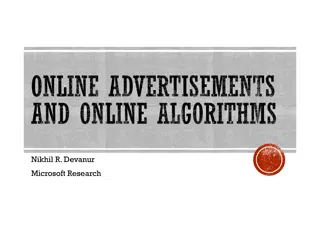Predicting NFL Game Outcomes Using Machine Learning Algorithms
This presentation delves into the development of a predictive model for NFL game outcomes using data analytics, machine learning algorithms, and statistical analysis. Components include data scraping, database management, and algorithm implementations like Linear Regression, K Nearest Neighbors, Decision Trees, and Support Vector Machines. Learn about the background of R programming, the concept of Linear Regression, its pros and cons, and the process of model building and prediction.
Uploaded on Feb 19, 2025 | 2 Views
Download Presentation

Please find below an Image/Link to download the presentation.
The content on the website is provided AS IS for your information and personal use only. It may not be sold, licensed, or shared on other websites without obtaining consent from the author.If you encounter any issues during the download, it is possible that the publisher has removed the file from their server.
You are allowed to download the files provided on this website for personal or commercial use, subject to the condition that they are used lawfully. All files are the property of their respective owners.
The content on the website is provided AS IS for your information and personal use only. It may not be sold, licensed, or shared on other websites without obtaining consent from the author.
E N D
Presentation Transcript
Cody Hock Senior Project presentation Fall 2014
NFL Predictions Using R Machine Learning algorithms My project was to gather NFL statistics and use them to develop a way to predict the outcomes of future NFL games. Review each component and then predict this weeks games!!!
Components PHP Scraping webpages with regex for NFL stats Sending output of this to .csv files MySQL Use C# to combine smaller regex outputs Load resulting .csv files into a DB R Getting the data from MySQL Formatting proper data to be used in different algorithms Linear Regression K Nearest Neighbors Decision Trees Support Vector Machines
year_kick.csv year _passdef. csv year _scores. csv year .csv year _rushing. csv Build.cs year _wins.csv MySQL year _passing. csv year _rushdef. csv
Demo 35.24.22.215 ~/Progs/Presentation
Background on R R was Invented by Robert Gentleman and Ross Ihaka at the University of Auckland in 1993. R is an implementation of S combined with lexical scoping semantics inspired by Scheme. Powerful in: data analytics, extracting and transforming data, fitting models, drawing inferences, and making predictions. The field of study interested in the development of computer algorithms for transforming data into intelligent actions is known as Machine Learning.
Linear Regression Way of specifying the relationship between the dependent variable (the value to be predicted) and one or more independent variables. Multiple linear regression isusing more than 1 independent variable. Correlation isa number indicating how closely the relationship of 2 variables follows a straight line (Pearson s Correlation Coefficient).
Linear Regression Cons Makes assumptions about the data Pros Most common approach for modeling numeric data (many to choose from) The model s form must be specified in advance Can be adapted to model almost any data Does not handle missing data well Provides the estimates of the correlations between the independent and dependent variables Only works with numeric inputs Requires some knowledge of statistics to understand the model
Linear Regression w/ various inputs Special Teams: 68.8% Defensive Stats: 71.8% PPG Stats: 71.43% QB Stats: 71.05% Rushing Stats: 71.99% Turnovers: 59.59% Combining: 74.06%
K-Nearest Neighbors Classifiers are defined by the characteristic of classifying unlabeled examples by assigning them to the class of the most similar labeled (K) examples. If a concept is difficult to define, but you know it when you see it, then nearest neighbors must be appropriate. ~ Brett Lantz Identifies K records in the training data that are most similar and assigns to the class of the majority of the neighbors. In general, it is not well suited for identifying a boundary.
K-Nearest Neighbors Pros Cons Does not produce a readable model limits ability to find relationships among features Simple and effective No assumptions about the underlying data distribution Slow classification phase Fast training phase Requires large amount of memory Non numeric and missing data require additional processing
K-Nearest Neighbors Accuracy: 71.99% with k = 7 Predicted Observed -1 1 Row Total -1 137 83 220 1 66 246 312 Column Total 203 329 532
Accuracy: 71.43% (Approx. 2x amount of variables) Accuracy: 71.99%
Decision Trees Builds a model in the form of a tree Comprises a series of logical decisions with Decision Nodes that indicate a decision to be made on that attribute Branches split from decision nodes indicating the decision s choice Leaf Nodes denote the result following the combination of decisions A decision tree is essentially a flow chart to follow. Recursive Partitioning (divide and conquer) is used to split the data into smaller subsets of similar classes. Possible terminations: All of the examples at that node have the same class No remaining features to distinguish the examples The tree has grown to the predefined size limit
Decision Trees Cons Pros Classifier that does well on most problems Biased toward splits on features having large number of levels Learning process can handle numeric or nominal features Easy to overfit or underfit the model Uses only most important features Small changes in training data can result in large changes of decision logic For small trees, the model is simple to interpret Large trees become difficult to interpret More efficient than more complex models
Decision Trees Accuracy: 70.49% with trials = 7 Predicted Observed -1 1 Row Total -1 123 97 220 1 60 252 312 Column Total 183 349 532
Support Vector Machines As surface that defines a boundary between points plotted in a multidimensional space according to their values. Hyperplane is the boundary in the multidimensional space which leads to fairly homogeneous partitions of the data. Maximum Margin Hyperplane (MMH) creates the greatest separation between two classes. Support Vectors arethe points from each class that are the closest to the MMH (each class must have at least 1). Uses the support vectors for classification and generally ignores those points farther from MMH.
Support Vector Machines Pros Cons Can be used for classification or numeric prediction Finding best model requires testing various combinations or parameters Not overly influenced by noisy (meaningless) data Slow to train, especially if the input has a large number of features Easier to use than Neural Networks Results in a complex black box model that is difficult (if not impossible) to interpret Recent increase in popularity for its accuracy in data mining competitions
SVM Mappings Rfbbdot (Radial Basis distance from origin one point): 73.12% Polydot (Polynomial): 73.12% Tanhdot (Hyperbolic Tangentsigmoid having an S shape curve): 73.31% Vanilladot (Linear): 73.31%
Comparisons in 2014 Home Team: 118-89-1 Microsoft Cortana: 135-73 ESPN s Cris Carter: 145-63* My Linear Regression: 146-62*
Vegas Line (MGM Mirage) Away Team Home Team Result Predicted Payout Dallas Cowboys Chicago Bears Cowboys 3.5 -13 -6 YES Pittsburgh Steelers Cincinnati Bengals Bengals 2.5 -21 3 NO St. Louis Rams Washington Redskins Rams 3.0 -24 -1 NO New York Giants Tennessee Titans Giants 3.5 -29 -3 NO Carolina Panthers New Orleans Saints Saints 9.5 -31 14 NO Win/Loss New York Jets Minnesota Vikings Vikings 4.0 6 11 YES 11-5 Baltimore Ravens Miami Dolphins Dolphins 3.0 -15 2 NO Indianapolis Colts Cleveland Browns Colts 3.5 -1 -2 YES Spread Tampa Bay Buccaneers Detroit Lions Lions 10.5 17 12 YES Houston Texans Jacksonville Jaguars Texans 7.0 -14 -11 YES 7-9 Buffalo Bills Denver Broncos Broncos 9.0 7 7 YES Kansas City Chiefs Arizona Cardinals Chiefs 2.5 3 1 YES Seattle Seahawks Philadelphia Eagles Seahawks 2.0 -10 4 NO San Francisco 49ers Oakland Raiders 49ers 8.5 11 -8 NO New England Patriots San Diego Chargers Patriots 4.5 -9 -4 NO Atlanta Falcons Gotham City Packers Packers 13.0 6 14 NO
R Demo R-Studio
Grading Feature Points Program can index multiple pages for data collection 2 Regular Expressions gather the data required for the project (this is the foundation of the project) 15 Program can parse the results from each Regex into a .csv file for use later on 5 Refactoring code in PHP (1 per method) 3 C# program can parse all of the separate .csv files into the two that are needed for each year 5 Create and manage my own MySQL database (1 database, 2 tables) 3 Can load the .csv files into the proper tables in my NFL database (1 per table) 2 Points reserved for R 25 A B C D F 52 - 60 45 - 51 38 - 44 31 - 37
Thank You Wikipedia Stack Overflow Sean Forman, President, Sport Reference LLC Michigan Technological University CRAN (Comprehensive R Archive Network) The University of Toronto CRAN (Comprehensive R Archive Network) Brett Lantz, author, Machine Learning with R Jared P. Lander, author, R for Everyone Microsoft Cortana, NFL Predictor MGM Mirage, NFL Odds ESPN


